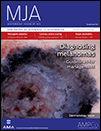Clinical practice guidelines for the diagnosis and management of melanoma: melanomas that lack classical clinical features
Abstract
Introduction: A Cancer Council Australia multidisciplinary working group is currently revising and updating the 2008 evidence-based clinical practice guidelines for the management of cutaneous melanoma. While there have been many recent improvements in treatment options for metastatic melanoma, early diagnosis remains critical to reducing mortality from the disease. Improved awareness of the atypical presentations of this common malignancy is required to achieve this. A chapter of the new guidelines was therefore developed to aid recognition of atypical melanomas.
Main recommendations: Because thick, life-threatening melanomas may lack the more classical ABCD (asymmetry, border irregularity, colour variegation, diameter > 6 mm) features of melanoma, a thorough history of the lesion with regard to change in morphology and growth over time is essential. Any lesion that is changing in morphology or growing over a period of more than one month should be excised or referred for prompt expert opinion.
Changes in management as a result of the guidelines: These guidelines provide greater emphasis on improved recognition of the atypical presentations of melanoma, in particular nodular, desmoplastic and acral lentiginous subtypes, with particular awareness of hypomelanotic and amelanotic lesions.




